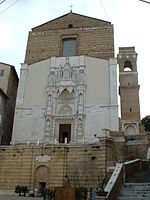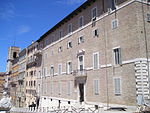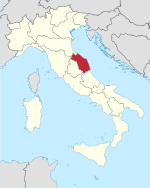Roman Catholic Archdiocese of Ancona–Osimo

The Archdiocese of Ancona–Osimo (Latin: Archidioecesis Anconitana-Auximana) is a Latin Church ecclesiastical territory and metropolitan see of the Catholic Church in the Marche region of Italy.It has existed in its present form since 1986, when the Archdiocese of Ancona was united with the historical Diocese of Osimo. Since earliest times, the diocese has been directly subject to the Holy See without intermediate authorities.The archbishop has his episcopal throne in the Cathedral of Ancona, while the Cathedral of Osimo has the status of a co-cathedral. In the 17th, 18th, and 19th centuries, the archbishop of Ancona was frequently a cardinal. One, Prospero Lambertini, became Pope Benedict XIV.
Excerpt from the Wikipedia article Roman Catholic Archdiocese of Ancona–Osimo (License: CC BY-SA 3.0, Authors, Images).Roman Catholic Archdiocese of Ancona–Osimo
Piazza del Duomo, Ancona
Geographical coordinates (GPS) Address Nearby Places Show on map
Geographical coordinates (GPS)
| Latitude | Longitude |
|---|---|
| N 43.6253 ° | E 13.5101 ° |
Address
Duomo di San Ciriaco
Piazza del Duomo
60121 Ancona
Marche, Italy
Open on Google Maps










